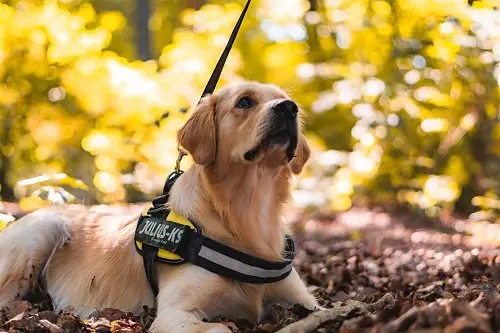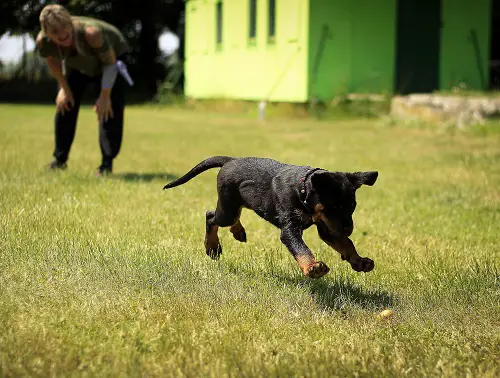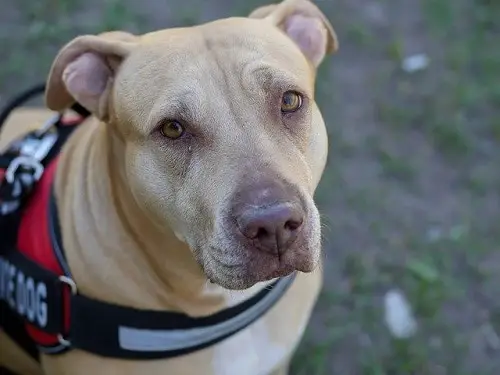Service dogs are awesome companions to help us enjoy life regardless of our conditions. Unfortunately, most people can’t afford them because they are very expensive.
That’s why you might wonder if training an assistance dog yourself without any professional background or help is possible. Well, let me share with you what I’ve found on this subject!
According to the ADA*, service dogs don’t require to be trained by professionals. So you can train your dog for assistance purposes yourself.
But it takes a lot of time and energy to teach him everything he needs to help you with a specific disability. You also have to make sure the four-legged companion you choose is suitable for your needs!

*ADA is the Americans with Disabilities Act that prohibits discrimination against people with limited physical or mental conditions in multiple areas such as employment, transportation, etc. In other words, it’s the ultimate resource that determines the rules and requirements for service dogs.
Even if training an animal for assistance work without any professional is possible for most people, it doesn’t mean it’s easy. You must know a lot of information for preparing your dog to help you with your specific conditions.
Making sure he’s suitable for this purpose, developing your training skills, and many other things are essential. At the end of your reading, you will finally be ready to train a service dog yourself!
What Is A Service Dog & What Does He Do?
First of all, you should understand what exactly a service dog is. In short, it’s an animal trained to help a person who has a disability.
This type of companion can be great for guidance, medical alerting, mobility assistance, and many other jobs. A service dog can do several tasks for his owner to make him more independent from other people and improve his life in general!
There are several reasons why you should train or adopt an assistance dog. Whether you (or someone close to you) suffer from anxiety, depression, autism, or have physical restrictions, it might be the perfect solution for your situation.
To give you an idea of how useful service animals are, here are some tasks they can perform for you with training!
- Alert Other People For Help.
- Assist With Balance or Mobility Issues.
- Call 9-1-1.
- Carry Items For You.
- Do Daily Tasks. (Open/Close Lights, Assist With Making Bed, Etc.)
- Help You With Guidance & Orientation.
- Pick Up Things You’ve Dropped.
- Provide Support While Walking or Standing.
- Retrieve Useful Objects Such As Your Phone, Wallet, or Keys.
- Wheelchair Pulling.
- Etc.
I’ve only selected some of the responsibilities a service dog can have. With proper training, it’s impressive what your four-legged buddy can do for you. To discover more tasks he could assist you with, I highly recommend reading this list on the Atomic Hound blog!
Can You Self-Train A Service Dog?
The ADA doesn’t require you to have any professional experience to train an assistance dog. It’s therefore legal to do so in the comfort of your home, and many regular people have trained a furry assistant themselves.
On the other hand, training service dogs isn’t as simple as it might sound. You will have to put in a lot of time, energy, and maybe money to do it yourself.
What Are The Other Alternatives To Get An Assistance Dog?
If you’re not able or don’t want to train a service dog yourself, there are still other options. You could either get one already prepared for this type of work or seek help from an expert in this area.
The main downside of those two alternatives is the price. It’s expensive to take care of and train an assistance dog correctly, so adopting one will cost you a lot of money.
Service Dog Organizations.
Many specialized organizations and individuals are training dogs for different assistance needs. With their experience and the variety of candidates available, they will certainly find an excellent match for you.
However, their service dogs can cost anywhere from $15,000 to $30,000. Let’s be honest; most people don’t have that much money available right now.
That’s why some organizations may be able to provide you with one at no cost depending on your disability or offer you financial aid if you can’t afford it.
Professional Trainers.
Another option is to hire an experienced dog handler to help you train your buddy for assistance. The main benefit of this alternative is the personalized service you will receive. Thus, a professional trainer can help you or directly train a service dog specifically for your needs.
Just as with organizations, the trainer’s expertise and time are not cheap. The initial investment isn’t as high as adopting a dog that’s already trained, but it can cost between $150 and $250 per hour.
You should also know that it can take up to two years of constant training before your companion is ready to assist you with your conditions efficiently. Therefore, the total amount will probably be slightly less important, but the time you have to invest is another factor to consider.
That’s why many people decide to train a service dog themselves. If you’re ready to put in some time and energy instead of money, I still have a lot of useful information to share with you!
Is Your Dog Suitable To Be Trained For Assistance Work?
To train an animal for service work, he needs to be appropriate for this purpose. Unfortunately, not all dogs are good candidates to help people with a disability.
They must have the right temperament, physical conditions, age, and other characteristics to be well-suited for assistance.
Service Dog Requirements!
The ADA Requirements for Service Animals don’t have any restrictions or recommendations about what type of dog you should use for this type of work. The only thing they mention is that the four-legged buddy must be under the control of its handler.
So all dog breeds are eligible to be trained as service dogs. Nonetheless, some of them are more likely to be good candidates for assistance. Your disability and needs are also important to determine what type of companion you should be looking for.
What Makes Good Service Dogs?
There are many traits that you want an assistance animal to have. From the size to personality passing by intelligence, it’s not always easy to understand what to look for in service dogs. To understand if your buddy is suitable for this type of work, here are some things to consider.
- Appropriate Size. (Relatively Tall & Large)
- Calm & Friendly Temperament.
- Easy To Train.
- Strong Desire To Please.
- Good Health Conditions.
- Intelligence.
- Strong Work Drive.
Apart from the general common traits assistance dogs have, the type of tasks you need a service animal is also important to consider.
For example, Pomeranians are well-suited for medical alerting or to help deaf people. However, they aren’t tall and solid enough to support people with mobility issues.
Best Assistance Dog Breeds!
If you don’t have any candidates in mind yet, you might want to know the most popular breeds for this purpose. Some types of dogs are more likely to be appropriate for service work than others.
Their size, personality, and other traits can make them better assistants. So let me share with you my list of the best service dog breeds!
- Labrador Retriever.
- Golden Retriever.
- German Shepherd.
- Standard Poodle.
- Boxer.
- Great Dane.
- Border Collie.
- Bernese Mountain Dog.
- Pit Bulls.
- Etc.
Can You Train Any Dog Yourself Successfully For Service Work?
The ADA doesn’t have any restrictions about the breed or other physical characteristics to become an assistance animal. Nonetheless, it doesn’t mean every dog is suitable for this purpose.
As I’ve already shared with you, age, temperament, size, trainability, and many other traits are important to consider.
To help you understand how important is the selection of your furry assistant, I’ve found an impressive statistic on the AKC blog: “The drop-out rate of professional service dog organizations can be as high as 50 to 70 %.”
In other words, not every four-legged companion is well-suited to be trained for this type of work. If an expert can’t teach assistance skills to one candidate out of two, you must choose your service dog carefully.
To avoid doing all the work for nothing, I would check with a professional trainer if your buddy is worth the investment in time and effort!
How To Train Your Service Dog Yourself?
Once you’ve found a companion that’s suitable for your needs, you have to prepare him for assistance work.
Even if he has the perfect temperament and traits to become a service dog, performing specific tasks such as opening doors or guiding someone isn’t instinctive. That’s why training is the ultimate factor that makes an animal good for helping people with a disability!

When Should You Start Training Your Service Dog?
As you probably already know, puppies can learn faster because they are still young and curious. That’s one reason why you should start training your assistance dog as soon as possible.
Another great advantage of beginning his education young is that you won’t have to replace bad habits or behaviors.
On the other hand, some professionals prefer to wait until a dog is between 1.5 and 3 years old before training him for service. It’s easier for them to understand if he’s well-suited for this type of work at an older age when he has been exposed to more things.
However, always keep in mind that an assistance dog can take up to two years before mastering all the skills he needs to help people. So most people should start training their four-legged buddy while he’s young and eager to learn.
Teach Your Dog Basic Obedience & Good Manners.
First of all, your helpmate should be well-trained and act properly in public to assist you with your disability. The ADA clearly states that a service dog must be under control. Without proper obedience training, socialization and manners, it’s practically impossible.
That’s why you should prepare your pup for assistance work as soon as he’s ready to learn and explore the world. Teaching him the fundamental commands, exposing him to strangers or pets, and many other things could help him develop essential service dog skills!
Advanced Service Dog Training.
After some basic training and preparation, you should move on to the next level. For assistance, your dog must be reliable and well-behaved all the time.
Whether he’s on a leash, off-leash, or around wild animals, it’s you must have control over him. So teaching him self-control, working on his focus, and improving his obedience are quite important to help him become an excellent service animal.
Once your furry assistant is well-trained, you can start teaching him how to perform specific tasks. For example, you might want him to retrieve your phone when necessary if you have mobility issues.
To help your service dog in his learning curve, you should make the tasks as simple as possible. In my example, your phone case should be easy to differentiate from others and convenient for him to grab and carry in his mouth.
With an appropriate command, a lot of work, and consistent practice, you will be able to collaborate and improve your quality of life.
The type of tasks you train your dog for will vary according to your conditions. You won’t need him to do the same work for helping you with mobility restrictions as you would for diabetic or medical alerting. Thus, you could make an ultimate list of things you want him to learn.
Regardless of how obedient or determined your furry friend is, it’s essential to train him slowly. The best way to improve his skills gradually in the long term is with regular and short sessions.
If you get frustrated or don’t know what to do along the way, you might consider seeking help from a professional trainer.
How Long Does It Take To Train Your Dog For Assistance Work?
The United States doesn’t have a minimum requirement of training time for service dogs. However, the IAADP (International Association of Assistance Dog Partners) has general guidelines to help you out.
This non-profit corporation suggests 120 hours as the minimum time for training, including at least 30 minutes of socialization in public places for 6 months or more.
On the other hand, you might have to train your companion for up to two years depending on skills and conditions. There’s no minimum or maximum according to the law. But please take the time you need to educate your service dog properly.
Is There Anything Special You Need For Training Your Own Service Dog?
First of all, you must have some experience with dog training. Socialization, teaching commands, and communicating with your service animal required certain skills.
Although it’s not impossible to train him without any specific background, I wouldn’t recommend it unless you’re dedicated. Depending on your training technique and the disability you have, you might need additional gear such as an appropriate harness, a clicker, or some treats.
Besides equipment, your personality is another element to consider before getting started. Qualities such as patience, determination, and positivism are essential for training your service dog efficiently and successfully.
What About The Registration?
According to the ADA, you don’t need to register your service dog. Nonetheless, you might have to explain yourself if he doesn’t wear any identification accessories or if your disability is not obvious.
The staff in public places are only allowed to ask you two questions about your assistance animal:
- Is the dog a service animal required because of a disability?
- What work or task has the dog been trained to perform?
They can’t ask you anything about your disability. It also means you don’t have to show any proof like your medical documentation or an identification card for your dog.
The only valid reason to refuse him access is if he’s out of control or not housebroken. With that in mind, you can understand better why training is so important for service animals!
Tips To Start Training An Assistance Dog!
With all the information above, training your four-legged companion to help you with your disability seems complicated. Indeed, this adventure will require serious commitment and a lot of time. Before letting you go, I’ve some pieces of advice to help you prepare your dog for service work.
Start Simple & Be Patient!
Whether you choose to work with a puppy or an adult dog, you shouldn’t start with too advanced and intense training. Beginning with the basics is ideal for your helpmate to improve his skills effectively.
Furthermore, service dog training is all about patience and consistency. That’s why you should always respect your buddy’s learning pace!
Work On The Fundamental Service Dog Skills!
To assist you with your disability, your buddy must learn many different things. However, it’s important to have a solid foundation before adding up new skills.
Every service dog should respond to his name, remain calm in public places, and be obedient to his handler. Thus, teaching your helpmate basic training commands, good manners, and other fundamental skills is essential.
Understand What Type Of Assistance You Need!
How can you possibly find the perfect dog for your conditions if you don’t know what to look for? To choose an appropriate candidate for your needs, you must clarify what they are.
For example, you can write down every task you would want him to help you with. Then, it will be much easier to find the right match and train him to assist you with your disability.
Have Fun During Training Sessions!
Even if conditioning your dog for service work won’t be easy, it doesn’t mean you can’t have fun doing it. Spending time together, learning new skills, and bonding with him can be very pleasant for both of you.
In fact, I don’t recommend training your assistance animal if you don’t enjoy it. Investing that much time and energy in something you don’t love doing isn’t worth the sacrifice, in my opinion!
Last Thoughts About Training A Service Dog Yourself!
Finally, you don’t have to wait on huge waiting lists or pay the high price to get an assistance animal. With patience, determination, and commitment, you can train a service dog yourself. To resume the whole process, here are 5 steps to follow!
- Understand & Clarify Your Needs.
- Find An Appropriate Candidate To Assist You.
- Prepare Your Service Dog With Socialization, Basic Training, Etc.
- Take Him In Public Places & Improve His Obedience.
- Start Advanced Training & Teach Your Helpmate How To Perform Specific Tasks.

If you get stuck along the way, it’s always possible to get a professional trainer for consulting or assistance. With that said, you’ve all the information you need to train a service dog yourself.
I hope my article will help you find the perfect partner to make your life more enjoyable and become independent regardless of your conditions!
